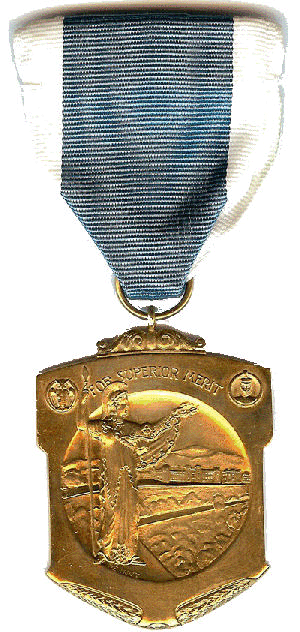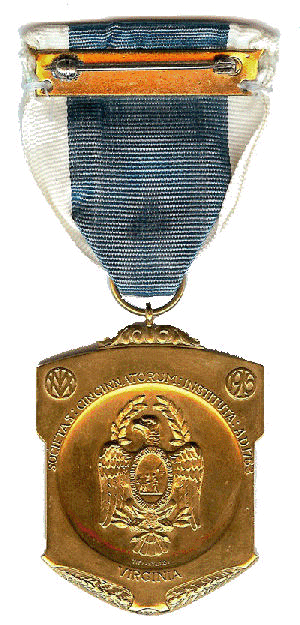At the annual meeting of the Society of the Cincinnati in the State of
Virginia in 1913 it was decided to institute two annual scholarships of $250
each at the Virginia Military Institute, and to "provide annually for the gift
of a gold medal of the Society of the Cincinnati in the State of Virginia, of an
intrinsic value of not less than $75, to a cadet of the graduating class of each
institution." In the following year, the matter having been arranged with the
Superintendent of the Virginia Military Institute, the Society resolved:
"That the medal be awarded annually by the proper officials of the Virginia
Military Institute to the member of the first class who has shown in the
greatest degree during his career at the Institute, Excellence of character and
efficiency of service.
That the Secretary be instructed to communicate with
Sir Moses Ezekiel, a
distinguished alumnus of the Virginia Military Institute and an artist of wide
reputation, and invite him to make a design for the medal."
Sir Moses Ezekiel was well qualified to design the medal, for he was steeped in
the traditions of the Virginia Military Institute, so often known as the West
Point of the South. He was a cadet there in 1861 and with others joined the
Confederate Army and fought in the battle of New Market. After the war he
returned to the Institute and graduated with honors in 1866. In his studio in
the Baths of Diocletian at Rome, where he did his best-known work, he designed
the medal, which was at first struck by Tiffany and Company, of New York, and
more recently by the Bailey, Banks and Biddle Company, of Philadelphia.

Medal awarded annually at the Virginia Military Institute
by the Virginia Society of the Cincinnati, 1913.
(Obverse). Hume #7.

Medal awarded annually at the Virginia Military Institute
by the Virginia Society of the Cincinnati, 1913.
(Reverse). Hume #7.
44mm x 35mm. Gilt.
The medal (Hume #7) is of dull gold, somewhat shield shaped, 1-5/8 inches length by 1¼ inches in width. In the center of the medallion is a circle in low relief in which is depicted the Virginia Military Institute, with the Blue Ridge in the distance. At the left is a female figure in armor, holding spear in her right hand, and her left extending towards the Institute. The head of the figure and the top of the spear extend beyond the circle. Above, in a small circle at the left, is an owl, typifying wisdom, and at the right the head of a cadet, typifying military science. Between these two small circles, which are 3/8-inch in diameter, is the legend: For Superior Merit, below the central circle are branches of laurel and oak leaves.
The reverse bears the Eagle of the Cincinnati in the central circle, below which is the maker's imprint: Tiffany & Co. Above are two small circles, of the same size as those on the obverse, the left bearing the monogram V.M.I., and the right bearing the date 1913. Above the large circle is the legend: Societas Cincinnatorum Instituta A. D. 1783, and below the circle the word: Virginia. The branches of laurel and oak leaves are repeated on the reverse.
The medal is suspended by a scroll from the official ribbon of the Society of the Cincinnati, namely, light blue edged with bands of white ¼ inch in width, the whole ribbon being 1½ inches in width. The ribbon hangs from a hidden bar pin so that the medal may be worn.
The Superintendent of the Virginia Military Institute states that the Cincinnati Medal is considered the highest award open to cadets of the institution, and is most eagerly sought. The award is based not merely on academic standing, but on character, leadership and evidence of the ideals of which the Virginia Military Institute has always stood.
Last Page | Next Page | Return to First Page
All Rights Reserved.
Legal & Privacy Notices
